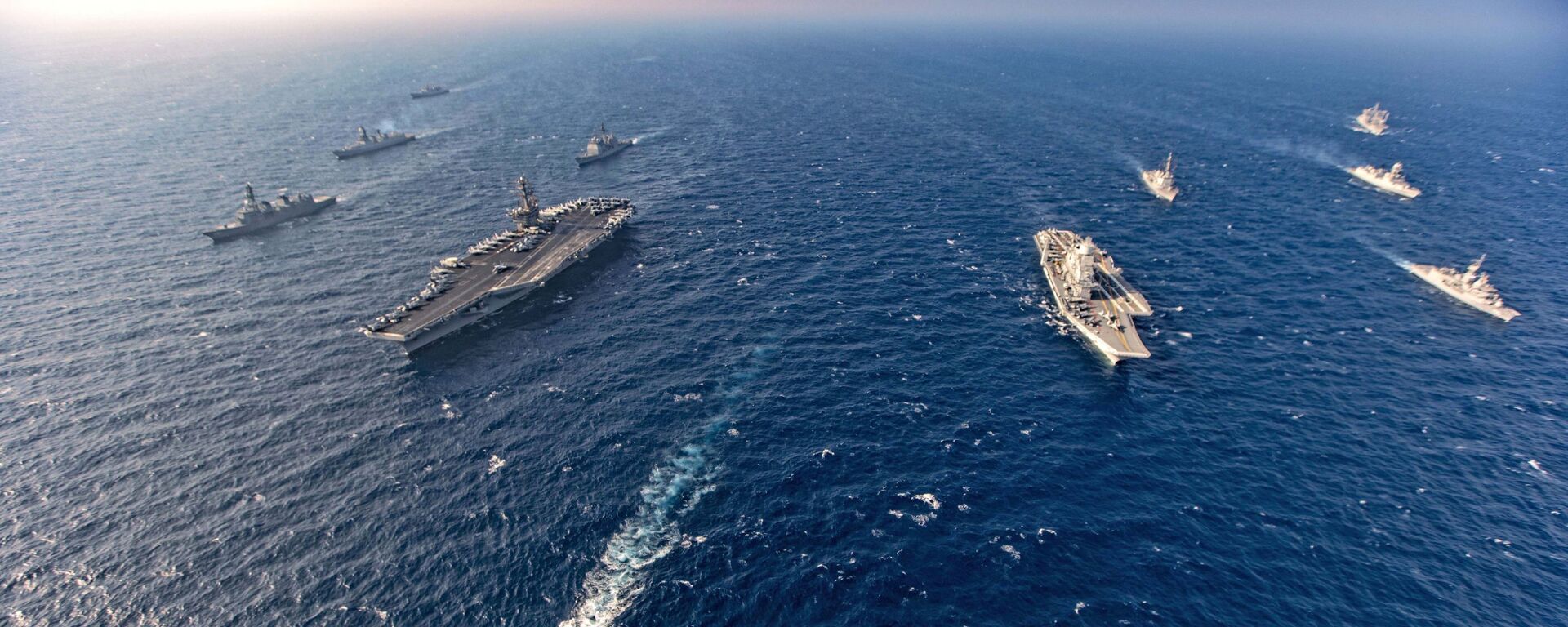https://sputnikglobe.com/20221116/india-permanently-deploys-movable-shelters--3d-bunkers-near-chinas-border-1104271362.html
India Permanently Deploys Movable Shelters & 3D Bunkers Near China's Border
India Permanently Deploys Movable Shelters & 3D Bunkers Near China's Border
Sputnik International
Beijing and Delhi have sought to out-build each other along the Line of Actual Control (LAC), a loosely demarcated boundary dividing the countries across the... 16.11.2022, Sputnik International
2022-11-16T06:42+0000
2022-11-16T06:42+0000
2022-11-16T06:42+0000
india
china
chinese people's liberation army (pla)
ladakh standoff
indian army
himalayas
https://cdn1.img.sputnikglobe.com/img/07e4/09/08/1080396301_0:0:3331:1873_1920x0_80_0_0_596b2a3cda8ef1e828c412db39eaa3fd.jpg
The Indian Army has built modular shelters and 3D bunkers in eastern Ladakh, indicating that the permanent deployment of troops and hardware in forward regions would be the new normal for India and China.India and China usually withdraw troops from forward locations to protect them from the chilly winters of the Himalayas, an annual event skipped by the two armies since the 2020 Ladakh stand-off.The newly constructed modular shelters for 22-24 thousand additional soldiers at 15-18 thousand feet maintain the temperature at around 15-20 degrees Celsius even in minus (-) 20-degree winters.To overcome the shortage of water in the cold desert of eastern Ladakh, artificial ponds were also built so that the soldiers could be supplied with water for 24 hours.Besides facilities for troops, 3D permanent defense structures have been constructed to station at least 450 tanks, mortars, and military vehicles to rush them in the shortest possible time to counter the enemy. One of the notable developments has been the G695 road or highway, running parallel to the LAC. According to Indian Army chief General Manoj Pande, the G695 road provides the military with the ability to not only move forces forward, but also switch them from one sector to another.Defense establishment sources said that 50-60 thousand Chinese soldiers remain stationed close to the border despite the disengagement completed in Eastern Ladakh in September. The tanks, missiles and fighter jets of China's People’s Liberation Army are also positioned close to the LAC.“In terms of infrastructure development, that is going unabated. There is road infrastructure, helipads, and airfields including roads right up to the passes,” he said regarding China's infrastructure development along the border.Last month, Defense Minister Rajnath Singh dedicated 75 strategic bridges, roads, and helipads to assist the armed forces in moving men and materiel rapidly in the event of a conflict with China.India and China share borders which stretch 3,488 km. The two countries have never agreed on the exact position of their border, which passes through rough, inhospitable terrain from Ladakh to Arunachal Pradesh state.
https://sputnikglobe.com/20221108/expert-indias-involvement-in-malabar-aimed-at-non-warfare-challenges-doesnt-target-china-1103892837.html
china
ladakh standoff
himalayas
Sputnik International
feedback@sputniknews.com
+74956456601
MIA „Rossiya Segodnya“
2022
Rishikesh Kumar
https://cdn1.img.sputnikglobe.com/img/07e4/08/04/1080055820_0:0:388:389_100x100_80_0_0_40018ee210946d65d49ffba4f4c008e1.jpg
Rishikesh Kumar
https://cdn1.img.sputnikglobe.com/img/07e4/08/04/1080055820_0:0:388:389_100x100_80_0_0_40018ee210946d65d49ffba4f4c008e1.jpg
News
en_EN
Sputnik International
feedback@sputniknews.com
+74956456601
MIA „Rossiya Segodnya“
Sputnik International
feedback@sputniknews.com
+74956456601
MIA „Rossiya Segodnya“
Rishikesh Kumar
https://cdn1.img.sputnikglobe.com/img/07e4/08/04/1080055820_0:0:388:389_100x100_80_0_0_40018ee210946d65d49ffba4f4c008e1.jpg
india china border dispute, chinese troops in ladakh, indian army, ladakh standoff, modular shelters, indian army chief manoj pande, bunkers near line of actual control, modi xi jinping
india china border dispute, chinese troops in ladakh, indian army, ladakh standoff, modular shelters, indian army chief manoj pande, bunkers near line of actual control, modi xi jinping
India Permanently Deploys Movable Shelters & 3D Bunkers Near China's Border
Beijing and Delhi have sought to out-build each other along the Line of Actual Control (LAC), a loosely demarcated boundary dividing the countries across the Himalayas. Though both states acknowledge existing tensions along the LAC, the stationing of thousands of troops by each side seems to be a regular affair now.
The Indian Army has built modular shelters and 3D bunkers in eastern Ladakh, indicating that the permanent deployment of troops and hardware in forward regions would be the new normal for India and China.
India and China usually withdraw troops from forward locations to protect them from the chilly winters of the Himalayas, an annual event skipped by the two armies since the 2020 Ladakh stand-off.
The newly constructed modular shelters for 22-24 thousand additional soldiers at 15-18 thousand feet maintain the temperature at around 15-20 degrees Celsius even in minus (-) 20-degree winters.
“These shelters are relocatable and can be erected at any new place in 2-7 days,” Defense sources said.
To overcome the shortage of water in the cold desert of eastern Ladakh, artificial ponds were also built so that the soldiers could be supplied with water for 24 hours.

8 November 2022, 14:12 GMT
Besides facilities for troops, 3D permanent defense structures have been constructed to station at least 450 tanks, mortars, and military vehicles to rush them in the shortest possible time to counter the enemy.
As per officials, these 3D bunkers withstand T-90 firing from a distance of 100 meters during trials. These bunkers have been designed in a way that extreme cold does not affect the performance of tanks and cannons.
One of the notable developments has been the
G695 road or highway, running parallel to the LAC. According to Indian Army chief General Manoj Pande, the G695 road provides the military with the ability to not only move forces forward, but also switch them from one sector to another.
Defense establishment sources said that 50-60 thousand Chinese soldiers remain stationed close to the border despite the disengagement completed in Eastern Ladakh in September. The tanks, missiles and fighter jets of China's People’s Liberation Army are also positioned close to the LAC.
Gen. Manoj Pande on Saturday said the situation along the LAC is “stable but unpredictable.”
“In terms of infrastructure development, that is going unabated. There is road infrastructure, helipads, and airfields including roads right up to the passes,” he said regarding China's infrastructure development along the border.
Last month, Defense Minister Rajnath Singh dedicated 75 strategic bridges, roads, and helipads to assist the armed forces in moving men and materiel rapidly in the event of a conflict with China.
India and China share borders which stretch 3,488 km. The two countries have never agreed on the exact position of their border, which passes through rough, inhospitable terrain from Ladakh to Arunachal Pradesh state.



